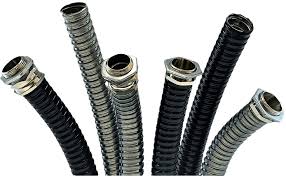Understanding Flexible Conduit: Benefits and Applications
Flexible conduit is an essential component in the world of electrical and telecommunications systems, offering a versatile solution for protecting and routing cables. This article provides an in-depth look at flexible conduit, discussing the different types available, the benefits of using flexible conduit, common industries and scenarios where it is utilized, and future trends in flexible conduit technology.
Introduction to Flexible Conduit
A flexible conduit is a type of tubing designed to encase and protect electrical wiring, cables, and data lines. Unlike rigid conduits, which are made from materials like steel or PVC, flexible conduits can bend and adapt to different shapes and spaces. This flexibility makes it an ideal choice for installations where rigid conduit would be impractical or impossible.
Types of Flexible Conduit
There are several types of flexible conduit, each with its unique properties and applications:
Metallic Flexible Conduit (MFC)
Metallic flexible conduit, typically made from steel or aluminum, provides robust protection against physical damage and electromagnetic interference (EMI). It is commonly used in industrial settings and areas where wiring needs extra defense against harsh conditions.
Non-Metallic Flexible Conduit (NMFC)
Non-metallic flexible conduit is made from materials like PVC, polypropylene, or nylon. It offers excellent resistance to moisture, chemicals, and corrosion, making it suitable for wet or corrosive environments. NMFC is often used in residential and commercial applications.
Liquid-Tight Flexible Conduit (LTFC)
Liquid-tight flexible conduit is designed to prevent water, oil, and other liquids from penetrating the conduit. It is typically constructed with a metal core covered by a waterproof plastic jacket. LTFC is ideal for outdoor installations and areas prone to moisture exposure.
Flexible Metal Conduit (FMC)
Flexible metal conduit, also known as Greenfield or BX, is commonly used for indoor applications where protection from physical damage is necessary. It is usually made from interlocked steel or aluminum and provides a balance of flexibility and durability.
Benefits of Using Flexible Conduit
Flexible conduit offers several advantages over traditional rigid conduit systems:
Versatility
Flexible conduit can bend and adapt to various shapes and spaces, making it ideal for installations in tight or complex areas. This versatility simplifies the routing of cables and reduces the need for additional fittings and connectors.
Easy Installation
The flexibility of the conduit allows for quicker and easier installation compared to rigid conduits. It can be cut to length on-site and easily routed around obstacles, reducing labor time and costs.
Protection
Flexible conduit with a conduit jacket provides excellent protection against physical damage, moisture, chemicals, and EMI. This ensures the longevity and reliability of the enclosed cables and wiring, reducing the risk of downtime and maintenance.
Aesthetic Appeal
In applications where aesthetics are important, the flexible conduit can be concealed more easily than a rigid conduit. It can be routed behind walls, ceilings, and other structures, maintaining a clean and professional appearance.
Common Industries and Scenarios
Flexible conduit is used across a wide range of industries and applications due to its adaptability and protective qualities:
Construction
In the construction industry, flexible conduit is employed for wiring installations in residential, commercial, and industrial buildings. Its ability to navigate tight spaces and bend around corners makes it ideal for new builds and retrofits.
Manufacturing
Manufacturing facilities utilize flexible conduits to protect electrical wiring and control cables in machinery and equipment. The conduit’s resilience to harsh conditions and flexibility helps maintain smooth operations and reduce maintenance.
Telecommunications
In telecommunications, flexible conduit is used to shield data cables and fiber optics from physical damage and electromagnetic interference. It ensures reliable communication networks and prevents signal degradation.
Automotive
The automotive industry relies on flexible conduits to protect wiring harnesses in vehicles. The conduit’s ability to withstand vibration, temperature changes, and exposure to fluids ensures the reliability and safety of electrical systems in cars, trucks, and other vehicles.
Marine
Marine applications require conduits that can resist corrosion and moisture. Flexible conduit is used to protect wiring in boats, ships, and offshore platforms, ensuring safety and functionality in harsh marine environments.
Future Trends in Flexible Conduit Technology
The future of flexible conduit technology is shaped by ongoing innovations aimed at enhancing performance, sustainability, and convenience:
Smart Conduits
Integration of smart technologies, such as sensors and IoT connectivity, into flexible conduit systems can provide real-time monitoring and diagnostics. This innovation can enhance predictive maintenance and improve system reliability.
Sustainable Materials
The development of eco-friendly materials for flexible conduits, such as biodegradable plastics and recycled metals, will reduce environmental impact and align with growing sustainability goals in various industries.
Enhanced Durability
Research and development in material science will lead to flexible conduits with improved resistance to extreme temperatures, chemicals, and physical stress, further expanding its applications in challenging environments.
Modular Systems
Modular flexible conduit systems that allow for easy assembly and disassembly will streamline installation and maintenance processes. These systems can offer increased adaptability and reduce downtime during repairs or upgrades.
Conclusion
Flexible conduit is essential for protecting and routing electrical and data cables in various industries. Its versatility, ease of installation, and protective features make it a key solution for modern electrical systems. With ongoing advancements in technology and materials, the future of flexible conduit holds even more innovative applications.
